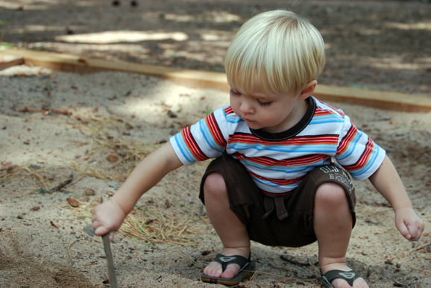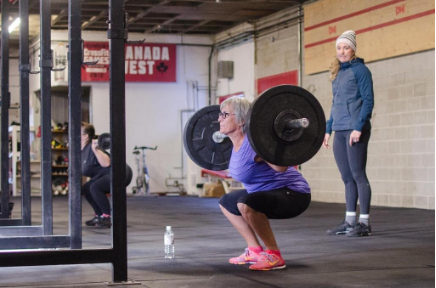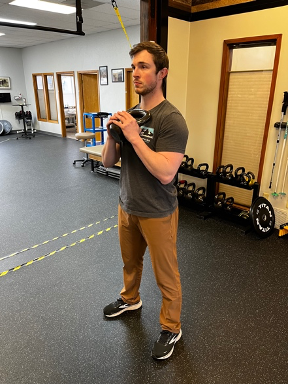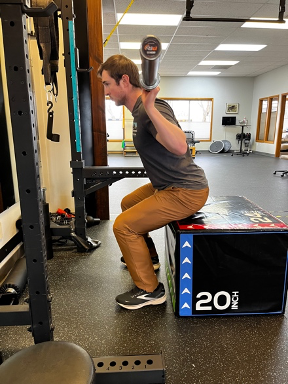The Back Squat
Squatting is a safe, functional movement with loads of benefits to our muscles, ligaments, cartilage, and bones. It is required throughout the lifespan whether we are exercising, rising from a chair or toilet, picking up objects, and more.
Squat Safety and Myths
Despite the functionality of the movement and its benefits, many are afraid to squat due to safety concerns. Let’s bust some myths:
Knees shouldn’t go past your toes.
Preventing your knees from going past your toes does reduce knee forces by ~22%, but also increases hip torque by 1070%. In order to spread the loads reasonably across your knees, hip, and back, “appropriate loading of all joints involved may require the knees to move past the toes” (1). In fact, the recommendation to not let your knees go past your toes “is based on a misinterpretation of existing data and should be removed in future practical literature” (2). Gradual exposure of forces to our knees strengthens them and allows them to become more tolerant to activities.
Squats cause wear and tear.
Grzelak et al used MRI to compare the knees of professional Polish weightlifters to a matched sedentary group and found that both the cartilage behind the knee and menisci were thicker in the weightlifters (3). They concluded that “many years of strength training in the full range of motion and using correct movement patterns results in functional adaptations of the articulating cartilage and meniscal tissue.”
Ligaments are harmed by squatting.
Similar studies have shown that ACL and PCL thickness are increased in professional weightlifters. Our femur bone also has a specific space, the intercondylar notch, that widens as we bend our knee. This allows more space for ligaments as we bend our knee and the shear forces during deep squats are not enough to cause harm.
Growth plates are damaged and stunt growth.
Resistance training in adolescents is supported by the National Strength and Conditioning Association (NSCA) and the American Academy of Pediatrics. Injuries occur with “misuse of equipment, inappropriate weight selection, and improper technique” (4). With proper education and supervision, children can thrive with resistance training such as squats.
Older adults should not squat.
We perform squatting motions throughout our lifespan and strong legs improve our ability to navigate the demands of life. Heavy resistance training has even been shown to improve bone density and function in older adults with osteoporosis (5).
Benefits
We see that squats create positive adaptations to our meniscus, cartilage, and ligaments but it has a multitude of other benefits as well. Squats strengthen leg and trunk muscles, improve bone density (6), reduce our risk of injury (7), and best of all reduce the risk of all-cause mortality by fifteen percent! (8).
Barbell Back Squat Technique
First time performing a barbell back squat? Here are the basic techniques to consider:
Stand with your feet as wide as your shoulders
Middle of the bar placed evenly across your shoulders
Toe out position should be whatever is most comfortable for you and your hip anatomy
Keep a neutral head and back position with chest upright
Hips release backwards as your knees bend forwards
Control the descent until knees are bent around 90 degrees (or further if able)
Push into the ground to return to your starting position
Introductory Variations
If you would like to introduce squatting into your strength program but are not quite ready for the full barbell back squat, below are some great alternatives to ease into the movement.
Pain with squats?
Various factors can contribute to pain while performing squats. If you are having difficulty with tolerating this important movement, give us a call and set up an appointment so we can help you get back to strength training!
Written by Benjamin Blakely PT, DPT, CSCS
References:
1. Fry AC, Smith JC, Schilling BK. Effect of knee position on hip and knee torques during the barbell squat. J Strength Cond Res. 2003;17(4):629-633. doi:10.1519/1533-4287(2003)017<0629:eokpoh>2.0.co;2
2. Hartmann H, Wirth K, Klusemann M. Analysis of the load on the knee joint and vertebral column with changes in squatting depth and weight load. Sports Med. 2013;43(10):993-1008. doi:10.1007/s40279-013-0073-6
3. Grzelak P, Domzalski M, Majos A, et al. Thickening of the knee joint cartilage in elite weightlifters as a potential adaptation mechanism. Clin Anat. 2014;27(6):920-928. doi:10.1002/ca.22393
4. Dahab KS, McCambridge TM. Strength training in children and adolescents: raising the bar for young athletes? Sports Health. 2009 May;1(3):223-6. doi: 10.1177/1941738109334215. PMID: 23015875; PMCID: PMC3445252.
5. Watson SL, Weeks BK, Weis LJ, Harding AT, Horan SA, Beck BR. High-Intensity Resistance and Impact Training Improves Bone Mineral Density and Physical Function in Postmenopausal Women With Osteopenia and Osteoporosis: The LIFTMOR Randomized Controlled Trial [published correction appears in J Bone Miner Res. 2019 Mar;34(3):572]. J Bone Miner Res. 2018;33(2):211-220. doi:10.1002/jbmr.3284
6. Mosti, MP. "Maximal strength training improves bone mineral density and neuromuscular performance in young adult women." Journal of St. & Cond Res 28, no. 10 (2014): 2935-2945.
7. Case MJ, Knudson DV, Downey DL. Barbell Squat Relative Strength as an Identifier for Lower Extremity Injury in Collegiate Athletes. J Strength Cond Res. 2020;34(5):1249-1253. doi:10.1519/JSC.0000000000003554
8. Shailendra et al (2022). Am J Preventive Med 63(2):277−285.







